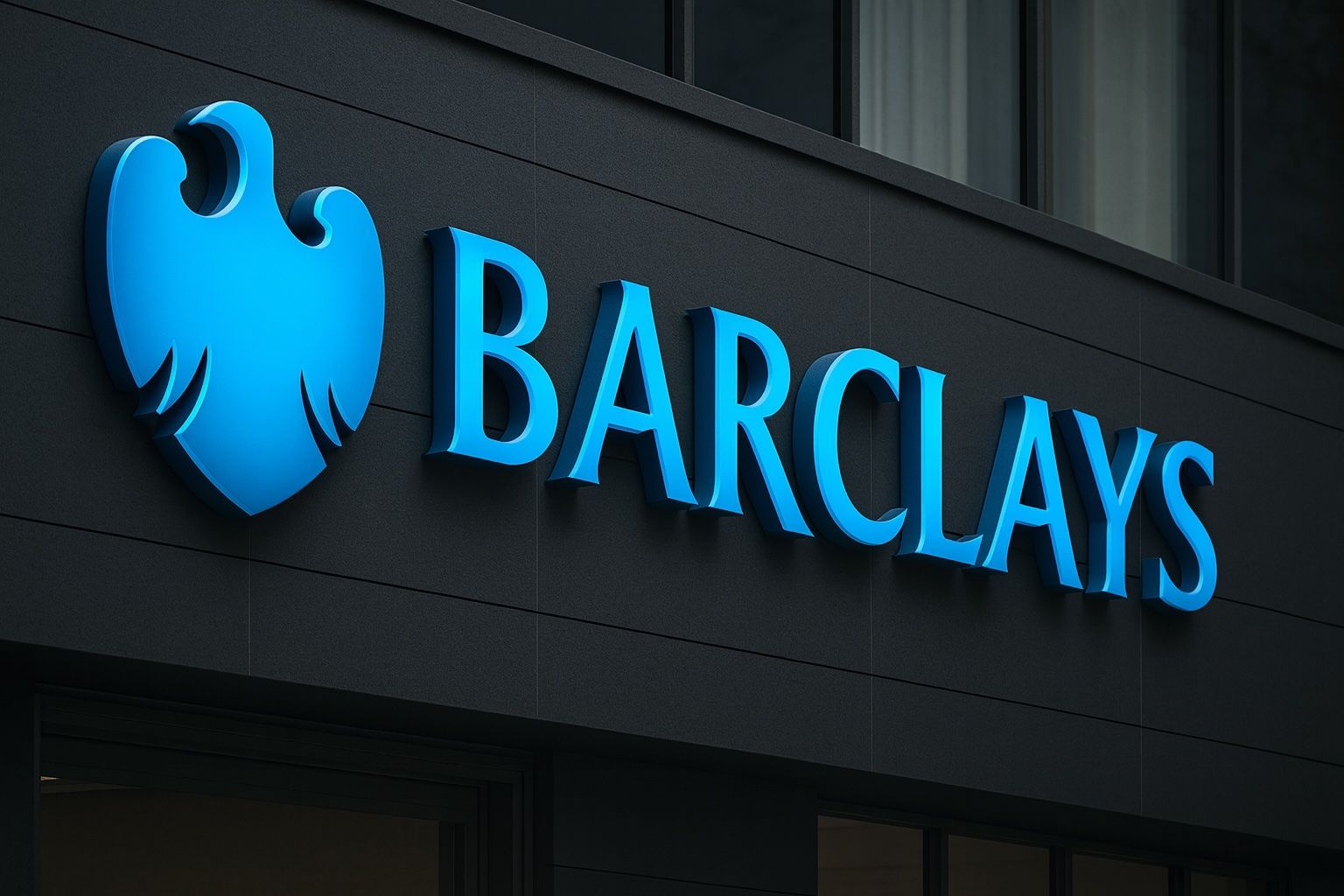- Banking Sell-Off: Barclays stock plunged around 5% on October 17 as part of a broad FTSE 100 slide, sparked by renewed fears over U.S. regional banks [1] [2]. London’s financial shares were hit hard, with Barclays the worst performer in the index.
- Fear vs Fundamentals: The rout was driven by panic after two mid-sized U.S. lenders revealed major loan losses, igniting concerns of hidden credit risks [3]. “Investors are selling first and asking questions later,” JPMorgan analysts noted, amid a “sell-first, ask-questions-later” mood sweeping bank stocks [4] [5]. Yet many analysts believe the drop is fear-driven rather than reflective of Barclays’ own fundamentals.
- Barclays’ Strength: In fact, Barclays’ earnings are robust. The bank’s profit before tax hit £5.2 billion in the first half of 2025 – up 23% year-on-year – with strong revenue growth [6]. It boasts a 12.3% return on tangible equity and has rewarded shareholders with a £1 billion buyback and rising dividends [7]. This solid performance suggests the bank is on a firm footing despite the share price wobble.
- Analyst Optimism: Several experts see the 5% dip as a potential buying opportunity. Bank of America recently raised its price target for Barclays to 450p (from ~435p) and reiterates a Buy rating [8]. The average analyst 12-month target is around 416p – implying roughly 15–16% upside from current levels [9]. A consensus of 11 out of 15 analysts rate Barclays a “Buy,” versus just 1 “Sell” [10]. Technical charts likewise remain bullish: Barclays shares have rallied from ~221p in spring to about 380p recently, forming an uptrend, and chartists say the stock could “keep rising” toward the 400p level next [11].
- Outlook and Risks: With Barclays set to report earnings on Oct 21 [12], many expect solid results – especially after U.S. banking giants smashed forecasts this quarter, a good omen for Barclays’ own investment banking arm [13] [14]. Still, risks persist: if credit problems deepen or a recession hits, bank stocks could face more pain. Some strategists caution markets could slip another 5–10% as these scares play out [15]. However, others maintain “the bull market remains intact” and view pullbacks like this as buying opportunities, believing the economy “may bend but not break” despite current jitters [16].
FTSE 100 Turmoil Drags Barclays Down
A wave of global banking jitters swept through markets in mid-October, and Barclays was caught in the undertow. On Friday, Oct. 17, the FTSE 100 index plunged roughly 1.5% at the open as investors reacted to trouble at two U.S. regional banks [17]. Barclays (LON:BARC) shares tumbled about 5% in the sell-off – the steepest drop among blue-chip constituents [18]. The stock fell from around 379p to the mid-350s pence range intraday [19], erasing about a month’s worth of gains in a single session.
What spooked the market? The trigger was bad news across the Atlantic: Zions Bancorp and Western Alliance, two U.S. regional lenders, disclosed significant loan losses and possible fraud in their portfolios. Zions stunned investors by writing off ~$50 million on a problematic California loan, while Western Alliance’s stock dived 11% amid its exposure to a related borrower [20]. These surprises “reignited concerns about credit quality across the banking sector,” coming just days after another U.S. lender’s collapse forced JPMorgan to take a $170 million charge [21]. In other words, fears spread that if one or two banks had hidden credit issues, there might be more “cockroaches in the pantry” – an unsettling prospect for investors in any bank.
As a result, investors rushed to safety. Money flowed out of bank stocks and into government bonds and gold, driving bond yields down and gold prices up [22] [23]. This classic flight-to-quality underscores how abruptly sentiment flipped from risk-on to risk-off. “It shows you can’t take credit quality for granted, and poor performing credit at one bank can drag down the group quite fast,” observed Stephen Biggar, a banking analyst at Argus Research, as he watched the contagion hit the sector [24]. That one-two punch of panic – first in New York, then in London – hammered Barclays’ share price even though nothing specific had changed in Barclays’ own business overnight.
Market commentators note that this was very much a fear-driven sell-off. “Faced with these surprises, investors are selling first and asking questions later,” JPMorgan analysts wrote, questioning why so many credit problems surfaced in quick succession [25]. In other words, traders reflexively dumped bank stocks like Barclays at the first whiff of trouble, even if those issues were thousands of miles away.
Is This Dip an Opportunity or a Warning Sign?
Whenever a high-quality stock like Barclays suddenly falls 5% in a day, the key question for investors is: does this drop reflect a real deterioration in the company’s outlook, or is it a knee-jerk market overreaction? In Barclays’ case, many market experts lean toward the latter – seeing an opportunity in the panic-driven dip, rather than a reason to run for the exits.
Barclays’ fundamentals remain strong. The bank’s latest financial results were impressive, suggesting the business itself is on solid footing. In the first half of 2025, Barclays’ profit before tax surged to £5.2 billion, a 23% jump from the prior year [26]. Second-quarter income was up 14% year-on-year, beating analyst forecasts [27]. The bank’s profitability is improving, with return on tangible equity reaching 12.3% (vs ~10% a year earlier) [28] – a level on par with global banking peers.
Barclays has also been returning cash to shareholders, a sign of confidence by management. It announced a £1 billion share buyback and paid a 3 pence per share half-year dividend as of its July results [29]. For investors, a lower share price means any future dividends and buybacks effectively go further. The Motley Fool’s Harvey Jones notes that long-term investors can simply “take advantage of the lower valuation and higher yield, to let dividends and capital growth compound from a lower base” instead of trying to time a quick rebound [30]. In short, if you believed in Barclays at 380p, seeing it at ~360p or less might be an even more attractive entry point – provided the investment case remains intact.
Crucially, nothing in Barclays’ own business appears to have fundamentally worsened this week. The credit troubles came from smaller U.S. banks with unique issues; by most accounts, they look like isolated incidents rather than a systemic problem. “Bank executives insist these issues are manageable and specific,” reports TS2.tech, noting that even Zions’ management called its loss an “isolated” event under investigation [31]. Major U.S. banks also seem relatively unfazed – the top five U.S. banks collectively set aside the smallest loan-loss reserves in two years last quarter [32], signaling they aren’t bracing for a credit apocalypse. That context suggests the panic may blow over without infecting healthier banks. If so, Barclays’ 5% slide could prove fleeting – a blip driven by fear, not fundamentals.
None of this guarantees Barclays’ share price will bounce straight back – but it does indicate that the long-term value of the franchise is likely intact. As veteran investors often say, markets tend to overshoot on both the upside and downside. When fear is in the driver’s seat, solid companies can get temporarily mispriced. This week’s turbulence may have handed investors a chance to buy Barclays at a rare discount.
Barclays’ Business Remains on Track
It’s worth zooming out to remember why Barclays stock had been rallying strongly before this dip. Even after the recent pullback, Barclays shares are up roughly 40% in 2025 so far [33], and about 70% above their spring lows [34]. This impressive run has been fueled by the bank’s performance and some easing of long-running concerns (like UK recession fears that haven’t materialized).
Strong Earnings Momentum: Barclays has delivered better-than-expected profits in recent quarters. After that 23% jump in first-half profit, CEO C.S. Venkatakrishnan (“Venkat”) affirmed that Barclays is “on track to achieve the objectives of our three-year plan” and is producing “structurally higher and more stable returns” for investors [35]. The bank’s strategy of shifting more focus to its UK consumer and business banking units (and slightly less to volatile investment banking) appears to be paying off. In Q2, for instance, UK division income climbed 11% year-on-year [36], and the UK corporate bank posted 14% revenue growth [37] – solid proof of domestic strength.
Investment Bank Tailwinds: Meanwhile, Barclays’ transatlantic investment banking arm has been a swing factor, and here the news is encouraging. The big U.S. banks just reported blowout third-quarter earnings, especially in investment banking and trading. For example, Bank of America’s net income jumped 23%, powered by a 43% surge in its investment banking fees, and Morgan Stanley’s investment banking revenue leapt 44% in Q3 [38] [39]. JPMorgan also saw double-digit gains in trading and dealmaking revenue [40]. Why does this matter? Because Barclays competes in many of the same arenas – and strong results on Wall Street hint that Barclays’ own Q3 results (due Oct 21) could get a nice boost. “Results by American mega banks always imply [for] Barclays,” notes Invezz.com, explaining that the U.S. banks’ stellar quarter “means [Barclays’] investment banking business will do well when it publishes its results later this month.” [41]. In fact, analysts expect Barclays to report about £7 billion in Q3 total income and £1.65 billion in after-tax profit, with its investment bank contributing roughly £3 billion of revenue [42]. Barclays’ investment banking division already pulled in £7.1 billion in revenue in the first half (up 13% YoY) [43], second only to its UK business. If the upcoming earnings confirm that strength, they could remind investors that Barclays’ core business is healthy – potentially catalyzing a relief rally for the shares.
Balance Sheet & Dividends: Barclays also maintains a solid capital position (Common Equity Tier 1 ratio ~14% [44]) which provides a cushion against surprises. This capital strength enabled the bank to increase shareholder payouts confidently. As mentioned, Barclays began a new £1 billion stock buyback over the summer [45] – effectively reducing share count and boosting future earnings per share. Its dividend for 2025 is on track to rise as well (analysts forecast ~9.7p per share in 2024 and 10.5p in 2025 dividends [46]). A rising dividend can help put a floor under the stock price, as income-focused investors step in on dips. Indeed, after this week’s drop, Barclays’ forward dividend yield is a bit higher – making the stock more attractive for those seeking income. This dynamic is why Motley Fool analysts suggest using the lower price to lock in a better yield and value, letting the power of compounding do the rest [47].
In short, Barclays as a business appears to be in good shape, and arguably stronger than it has been in years. The bank is growing earnings, returning capital to shareholders, and trading at valuations (around 9 times earnings [48]) that are not demanding. That provides some fundamental underpinning to the idea that the recent dip could be a buying opportunity rather than the start of a protracted decline.
What Do the Experts Say?
Analysts and market experts have been weighing in on Barclays in light of both its strong 2025 performance and the latest volatility. Here’s a roundup of the sentiment and forecasts:
- Broker Targets: Wall Street and City of London analysts remain broadly bullish on Barclays. Just last week (Oct 9), Bank of America raised its price target to 450p and reiterated a “Buy” rating [49], citing improving earnings and revenue mix. Many other brokers also updated models after Barclays’ Q2 results; the current consensus target is ~416p, about 16% above the latest price [50]. The most optimistic analysts see 500p or higher in the next year [51], while even the most cautious still peg fair value around 306p – suggesting limited downside. Out of 15 analysts tracked, 11 rate Barclays stock a Buy, 3 say Hold, and only 1 recommends Sell [52]. Such consensus optimism is a notable vote of confidence. It implies that professionals who study Barclays full-time generally believe the stock is undervalued after this pullback.
- Valuation Appeal: One reason experts are positive is valuation. Despite its strong gains in 2025, Barclays shares still look reasonably cheap. As Simply Wall St. pointed out, after a ~40% rally this year the stock trades on a price-to-earnings (P/E) ratio around 9 [53] – a discount to the broader market and many global peers. Its price-to-book ratio is also modest (~0.6–0.7), meaning the stock is priced at a significant discount to the bank’s book value (common for UK banks, but it suggests a margin of safety if Barclays continues improving returns). With earnings rising and large buybacks in play, some analysts see this valuation as too low to ignore, provided the economic backdrop remains stable.
- Technical Signals: Chart analysts also see encouraging signs. According to an Invezz technical analysis, Barclays’ stock has been in a steady uptrend for months and “remained above all moving averages” even before this dip [54]. The shares climbed from ~221p in May to ~380p by mid-October [55], tracing an ascending channel pattern. Even after the latest drop, the stock is near the lower end of that channel. Invezz noted a bullish flag formation on the chart – typically a continuation pattern – and wrote that “the most likely outcome is [that] the stock keeps rising, with the next key level to watch being the psychological point at 400p.” [56] In other words, the technical perspective suggests this pullback has not broken the positive trend; if anything, it may be setting the stage for a rebound toward new highs (around 400 pence and beyond) if buying interest returns. Of course, technical projections are not guarantees, but it’s notable that the market’s momentum and trend for Barclays had been upward prior to the recent hiccup.
- Expert Quotes: Many veteran investors advise looking past day-to-day fear. “Pullbacks are buying opportunities” has been a common refrain lately. “While some strategists warn the market could see another 5–10% pullback as it digests these credit scares, others maintain that ‘the bull market remains intact’ and view pullbacks as buying opportunities,” reports TS2.tech [57]. The broader context is that despite myriad worries (inflation, interest rates, geopolitics), stock markets in 2025 have been resilient. “Unless deeper cracks spread, many believe the 2025 economic expansion – and stock rally – ‘may bend but not break’ despite the current jitters,” TS2.tech adds [58]. This aligns with comments from fund managers who see dip-buying in quality names as a sound strategy as long as the economy avoids a severe downturn.
- Contrarian Views: That said, not everyone is pounding the table to buy banks today. A few analysts urge caution, noting that banking is a cyclical sector and that credit conditions could still worsen if interest rates stay high or a recession hits. The recent U.S. regional bank issues, while seemingly one-off, highlight that pockets of risk exist. If more problems emerge (e.g. rising loan defaults in a particular portfolio), bank stocks could face further selling. Moreover, the macro environment is uncertain – the Bank of England is signaling rate cuts may be on the horizon due to a cooling economy [59]. Slower growth or lower interest rates could squeeze bank margins. These skeptics argue that Barclays’ current valuation already factors in a lot of good news, and they prefer rivals like HSBC or Lloyds for different risk/reward reasons. It’s important for investors to weigh these risks and not assume any dip will automatically reverse quickly.
Stock Price Forecast – Cautious Optimism Ahead
Looking forward, the consensus outlook for Barclays is cautiously optimistic. The combination of strong internal performance and external market positioning suggests the stock has room to recover and even exceed recent highs, barring any new shocks.
In the near term, much will depend on whether the present banking scare dissipates. If the U.S. regional bank saga proves contained (as most bank CEOs insist it is), sentiment toward financial stocks should stabilize. Barclays’ upcoming Q3 earnings release (due next week) is a potential catalyst: a solid report could remind investors of Barclays’ strengths and help refocus attention on fundamentals rather than fear. Investors will be watching for updates on loan quality, any exposure to risky areas, and management’s outlook. Given Barclays’ diversified business – from UK credit cards to global investment banking – it stands to benefit from several trends (consumer spending resilience, market volatility boosting trading income, etc.). Any positive surprises in the results or guidance could spur a relief rally in the shares.
Market forecasts: As mentioned, analysts on average target GBX 416 for Barclays over the next 12 months [60]. That’s about 15% above the current price – a healthy gain, not including dividends (~2–3% yield). The high end of forecasts is around 500p [61], which would mark a return to pre-Global Financial Crisis levels not seen in over a decade. While that may be optimistic, it underlines that some see significant value in Barclays if it continues executing well. Even the lowest analyst target (~306p) is near the stock’s 52-week lows [62], suggesting limited downside unless conditions truly deteriorate. MarketBeat reports a similar consensus, with an average target ~424p and most analysts calling Barclays “outperform” or “buy.” [63]
On the technical front, traders will be eyeing key levels. The 380–390p zone has acted as resistance recently (around Barclays’ 52-week high of ~390p [64]). A break above 400p would be a bullish signal and could open the door toward mid-400s if momentum builds. Conversely, support appears to sit around 350p (the area of this week’s lows). Should the stock fall below that, it might test deeper support around the 320s (roughly where it started the summer). However, unless a broader market correction unfolds, few expect Barclays to give up all its 2025 gains. Its own share buyback program will be scooping up shares on the open market (providing some support), and value-oriented investors likely see sub-350p prices as compelling given the bank’s earnings trajectory.
Big picture: Barclays’ dip comes at a time when the financial sector has been performing well overall. Year-to-date, many bank stocks are up, riding higher interest income and resilient economies. The FTSE 100 itself is near multi-year highs. One off day – even a sharp one – doesn’t necessarily change that narrative. “There are increasing signs of storm clouds… now ‘bad loans at US regional banks’ [are] joining the list,” one market strategist commented, “but [this is] pouring fuel on an already flickering fire” of worries [65]. In other words, this episode added to the wall of worry but hasn’t fundamentally altered the landscape. If anything, long-term investors often welcome such volatility as a chance to buy quality stocks at a markdown.
For someone with a multi-year horizon, the case for Barclays arguably remains what it was a week ago – a growing dividend payer with improving returns, trading at a reasonable valuation, and leveraged to both the UK economy and global finance. Now it’s just available at a slightly cheaper price. Of course, anyone buying should remain aware of the risks (e.g. a potential uptick in loan defaults if consumers come under stress, or any future regulatory fines/investigations that banks like Barclays occasionally face). But those are standard risks that were present before; they are not new developments specific to this week’s events.
Conclusion
The sudden 5% dip in Barclays’ share price amid a broader market scare has put the spotlight on the stock. Is it an “unmissable” chance to buy at a discount, or a sign of trouble ahead? Based on the evidence so far, it appears more like the former – a knee-jerk selloff driven by contagious fear from abroad, rather than any Barclays-specific weakness. The bank’s underlying business is delivering strong results and returning capital to investors, which suggests the long-term value is very much intact. “Just take advantage of the lower valuation and higher yield… from a lower base,” as one analyst put it, recommending patience and focus on fundamentals [66].
That said, investors should stay vigilant. The banking sector is not without risks, and sentiment can swing quickly. We’ve seen that even distant problems (Utah bank loans gone bad) can send shockwaves through London trading floors. In the coming weeks, clarity on U.S. regional bank health, the trajectory of interest rates, and Barclays’ own earnings report will likely dictate where the stock heads next. If calm returns and Barclays posts solid numbers, this dip may indeed turn out to have been a golden buying opportunity – the kind of temporary markdown that long-term shareholders relish. On the other hand, if new credit problems emerge or macro risks escalate, Barclays could face further volatility along with its peers.
For now, the takeaway is this: Barclays shares are on sale relative to last week, and the core reasons to own the stock (strong profits, shareholder returns, an improving economy) remain in place. Many experts and analysts see the glass as half full – viewing the dip as a chance to grab a quality franchise at 5% off. As always, doing one’s own homework is crucial, but for those who have been eyeing Barclays, the recent turbulence might just have a silver lining. After all, as the saying goes, “be greedy when others are fearful” – and fear has certainly been in the air. If the storm passes, today’s fear could turn into tomorrow’s gains for investors bold enough to buy when the headlines are grim.
Sources: Barclays stock and market news [67] [68]; Expert analysis by TS2 and others on banking sector fears [69] [70]; Barclays financial results and shareholder returns [71] [72]; Analyst forecasts from Shares Magazine/Alliance News and Investing.com [73] [74]; Invezz/Investing.com technical outlook [75]; Strategist commentary on market outlook [76].
References
1. www.proactiveinvestors.co.uk, 2. www.proactiveinvestors.co.uk, 3. www.proactiveinvestors.co.uk, 4. ts2.tech, 5. ts2.tech, 6. www.globalmarketsinsider.com, 7. www.globalmarketsinsider.com, 8. www.sharesmagazine.co.uk, 9. uk.investing.com, 10. uk.investing.com, 11. uk.investing.com, 12. uk.investing.com, 13. uk.investing.com, 14. uk.investing.com, 15. ts2.tech, 16. ts2.tech, 17. ts2.tech, 18. www.proactiveinvestors.co.uk, 19. uk.investing.com, 20. www.proactiveinvestors.co.uk, 21. www.proactiveinvestors.co.uk, 22. www.proactiveinvestors.co.uk, 23. www.proactiveinvestors.co.uk, 24. ts2.tech, 25. ts2.tech, 26. www.globalmarketsinsider.com, 27. www.globalmarketsinsider.com, 28. www.globalmarketsinsider.com, 29. www.globalmarketsinsider.com, 30. uk.finance.yahoo.com, 31. ts2.tech, 32. ts2.tech, 33. simplywall.st, 34. uk.investing.com, 35. www.globalmarketsinsider.com, 36. meyka.com, 37. uk.investing.com, 38. uk.investing.com, 39. uk.investing.com, 40. uk.investing.com, 41. uk.investing.com, 42. uk.investing.com, 43. uk.investing.com, 44. meyka.com, 45. www.globalmarketsinsider.com, 46. admiralmarkets.com, 47. uk.finance.yahoo.com, 48. www.newsnow.co.uk, 49. www.sharesmagazine.co.uk, 50. uk.investing.com, 51. uk.investing.com, 52. uk.investing.com, 53. www.newsnow.co.uk, 54. uk.investing.com, 55. uk.investing.com, 56. uk.investing.com, 57. ts2.tech, 58. ts2.tech, 59. uk.investing.com, 60. uk.investing.com, 61. uk.investing.com, 62. uk.investing.com, 63. www.zacks.com, 64. uk.investing.com, 65. ts2.tech, 66. uk.finance.yahoo.com, 67. www.proactiveinvestors.co.uk, 68. www.proactiveinvestors.co.uk, 69. ts2.tech, 70. ts2.tech, 71. www.globalmarketsinsider.com, 72. www.globalmarketsinsider.com, 73. www.sharesmagazine.co.uk, 74. uk.investing.com, 75. uk.investing.com, 76. ts2.tech







